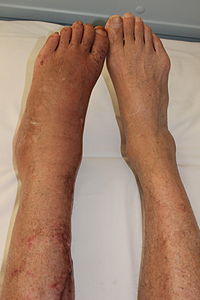
Photo from wikipedia
Little is known about the functional relationship between endoplasmic reticulum (ER) stress and development of pain hypersensitivity after nerve injury. The aim of this study was to investigate the role… Click to show full abstract
Little is known about the functional relationship between endoplasmic reticulum (ER) stress and development of pain hypersensitivity after nerve injury. The aim of this study was to investigate the role of ER stress in the development of pain hypersensitivity in the dorsal root ganglion (DRG) after spinal nerve ligation (SNL). SNL was performed in male Sprague-Dawley rats. Real-time PCR and immunohistochemistry were performed to investigate ER stress markers including glucose-regulated protein (GRP) 78, C/EBP homologous protein (CHOP), and spliced form of the X-box binding protein 1 (sXBP1) in L4 and L5 DRG. Behavioral assessment with von Frey filaments, radiant heat, and acetone stimulation was performed to investigate pain hypersensitivity. The ER stress inhibitor salubrinal was administered prior to and 1, 3, and 5 days after SNL treatment. Separately, the ER stress inducer tunicamycin was applied to L5 DRG. GRP78, CHOP, and sXBP1 mRNA and protein expression in L5 DRG was increased 1 and 3 days after SNL but returned to baseline 7 days after SNL. In L4 DRG, ER stress markers showed no remarkable change. Immunohistochemistry demonstrated that GRP78 expression was detected in the majority of DRG neurons and in satellite glial cells. Treatment with salubrinal inhibited CHOP expression in L5 DRG and alleviated pain hypersensitivity for 5 days after SNL. Tunicamycin induced ER stress in the DRG and pain hypersensitivity 2 h after treatment. These results demonstrated that ER stress is induced in the injured DRG and contributes to the development of pain hypersensitivity after nerve injury.
Journal Title: Neuroscience
Year Published: 2018
Link to full text (if available)
Share on Social Media: Sign Up to like & get
recommendations!